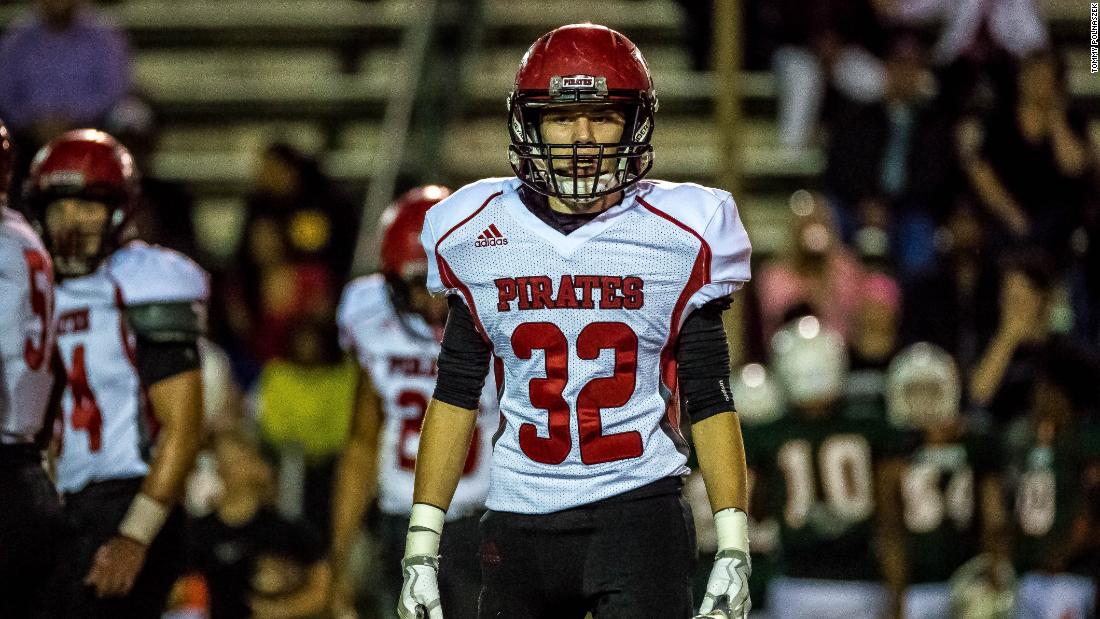
[ad_1]
Dylan Thomas, a 16-year-old linebacker for his Pike County High School football team, had fallen in the third quarter and needed to be helped off the field. His leg was feeling weird, he said.
As a doctor and trainer asked him questions and examined him, he became incoherent and lost consciousness. He was taken to a hospital but died two days later of a head injury.
“Any time I see one of our players on the ground, you just fear for the worst,” coach Webber said. “The worst happened this time.”
Dylan’s death has put further scrutiny on the inherent dangers of playing football and rattled this rural community of Zebulon, Georgia, about an hour’s drive south of Atlanta.
But amid the mourning, students and families have come together to support the Thomas family. On Friday night, for example, when Dylan went down on the sidelines, Dylan’s father rushed to join his ailing son, leaving his camera behind in the stands.
Steve Fry, the mayor of Williamson, said other members of the community recovered the camera and got it back to him in 45 minutes.
“That was just a show of how the community came together, and said hey I saw that camera, I know somebody’s got it, they’re holding it for him,” Fry said. “And from then on, it’s just been an all-out effort community-wide to help Dylan and his family.”
No evidence of negligence
The organization that oversees Georgia high school sports said there is no evidence of negligence in his death.
In reviewing the game film and speaking with school officials, the GHSA said there was no indication Dylan suffered an injury in the second quarter.
Webber said officials were not sure when or how in the game Dylan was injured. He said coaches reviewed video of the game to try to pinpoint what happened — if he had taken a big hit to the head, for example — but nothing stuck out.
“That makes it almost harder as well that we just didn’t know,” he said. “If you know, you can prevent things. But just the way that happened, it’s just devastating. It’s just sad.”
In the third quarter, Dylan fell to the ground and reported a problem with feeling in his leg. He was helped off the field and examined by an orthopedic surgeon and the Pike County certified trainer, the GHSA said.
When he lost consciousness, he was taken to the hospital nearby and then to another hospital in Atlanta. He died there on Sunday.
The high schooler was wearing a top-of-the-line Riddell SpeedFlex helmet that his parents had bought for him to prevent a head injury.
“Dylan’s dad took his own money and bought an NFL-quality helmet for Dylan, because he was somewhat concerned about head injuries,” said Fry.
‘I want to get out there and play for him’
Residents of Pike County, about an hour south of Atlanta, held a vigil Sunday at the high school football stadium to honor Dylan. His No. 32 jersey and the hashtags #DylanStrong and #PikeStrong are evident online and around the town, including at the Papa Johns restaurant where high school students hang out.
“At times like this everybody comes together and they just wrap their arms around and try to love everyone and support everyone,” Pike County High School principal Kevin Huffstetler said.
Fry said Dylan fell off the bench while being checked on the sideline during Friday’s game. After the teen went down, he woke up, said “I can’t feel my body,” and then passed out again, Fry said.
“I want to get out there and play for him because that’s what he’d want for us. He’d want us to play for him instead of just quitting,” he said.
‘He was a fighter’
In an emotional press conference, Webber said that his son and Dylan were friends and praised the teenager.
“He was an incredible young man with work ethic that you can’t believe,” Webber said. “He was the heart and soul of our defense. Just great student, great family, and the sky was gonna be the limit for him.”
Retaking the field without number 32 is going to be tough, he said.
“Inside him was a lion. He was a fighter, he was a tiger. There wasn’t a day when he didn’t come up there and practice his heart off,” Webber told CNN.
Nick Burgess, Dylan’s uncle, posted on Facebook that Dylan was the “golden child” in the family who brought everyone together.
“The one that had the biggest heart. The one that told me personally he was always scared to seriously hurt somebody on the field and never thought it would happen to him,” Burgess wrote.
Four of the deaths had “direct” causes from on-field trauma or injuries, and nine deaths were due to “indirect” causes such as heat stroke or cardiac arrest. The 2017 death toll was consistent with football-related fatalities dating back to 2000.
Nick Valencia and Samira Said reported from Zebulon. Eric Levenson reported and wrote in New York. CNN’s Devon Sayers and Marlena Baldacci contributed to this report.
[ad_2]Source link



